
Asia-Pacific EMC (APEMC 2015)
The 2015 Asia-Pacific International Symposium on Electromagnetic Compatibility (APEMC 2015) was successfully held on May 25-29 at the Grand Hotel, Taipei, Taiwan. This international symposium was organized by National Taiwan University (NTU) and the IEEE EMC Taipei Chapter, and was co-organized by the Bureau of Standards, Metrology & Inspection (BSMI) and Yuan Ze University, with the help from many academic and industrial organizations. People actively involving in organizing the conference include Prof. Pan-Chyr Yang (Honorary Chair of the symposium and President of NTU); Dr. Ming-Jong Liou (Co-Honorary Chair of the symposium and Director General of BSMI); Prof. Tzong-Lin Wu (General Chair, Director of the Graduate Institute of Communications Engineering of NTU, and former Taipei EMC Chapter Chair); Dr. Ding-Bing Lin (Technical Program Committee Chair, a professor of the Electronics Engineering Department, National Taipei University of Technology (NTUT), and current Taipei EMC Chapter Chair); and many other internationally renowned EMC activists and scholars. APEMC has been known as one the three greatest international EMC conferences. Since the first APEMC symposium held in Taiwan in 2005, this conference has steadily and robustly grown year by year. APEMC 2015 has reached an outstanding record of 256 paper submissions (among which 198 were published in oral or poster sessions), with 447 attendees coming from 22 countries or regions.
The conference was opened on May 26 by Prof. Pan-Chyr Yang (President of NTU), Dr. Ming-Jong Liou (Director of BSMI), Dr. Robert Scully (President of IEEE EMC Society), and Prof. Tzong-Lin Wu (General Chair of the symposium). They all wished that the high-quality technical program of the symposium can expedite the development of more advanced EMC technology.

Photos shows the invited guests after the open ceremony in APEMC 2015.
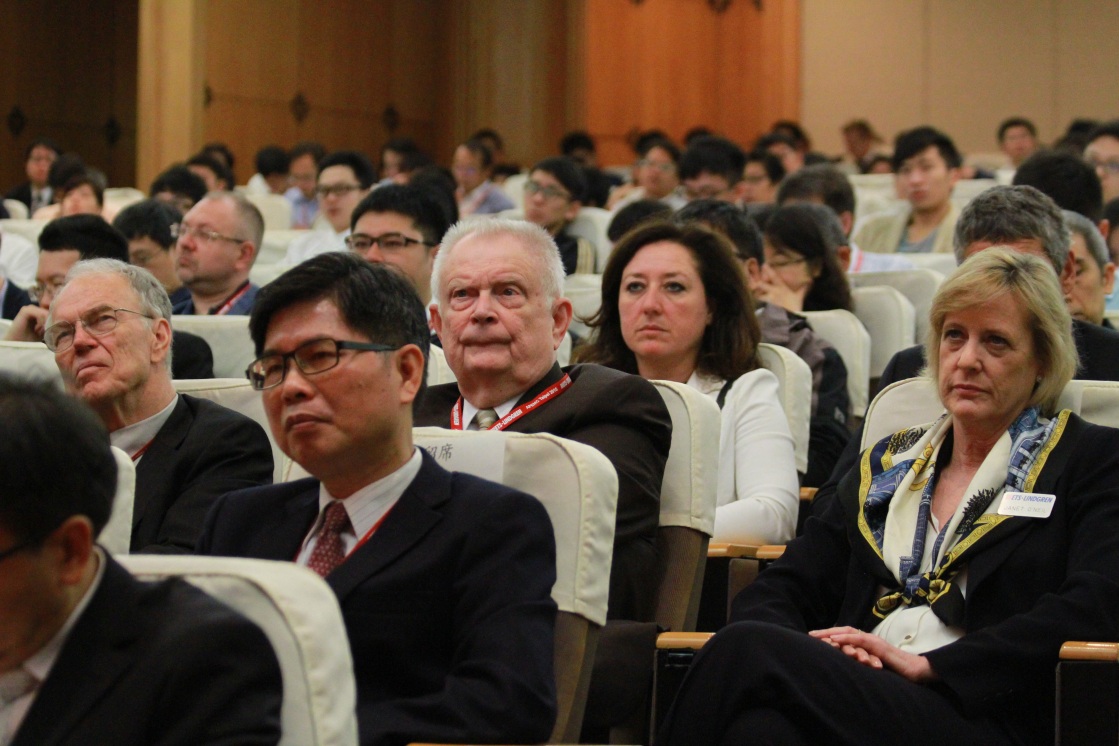
Attendees concentrated on listening to opening speeches.

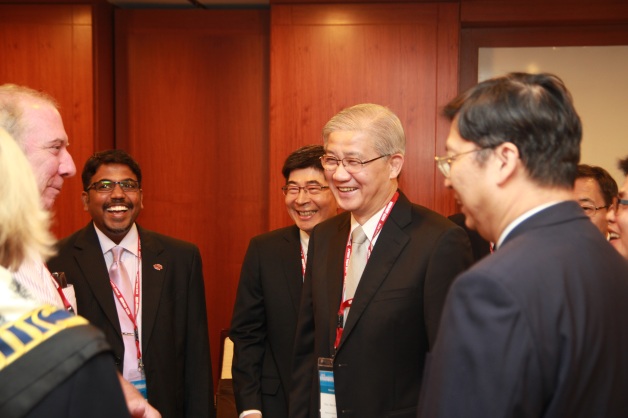
Keynote Speech
Right after the four short welcome speeches in the opening ceremony, Dr. Wen-Hann Wang, Intel Corporate Vice President and Managing Director of Intel Labs, delivered the first keynote speech, titled “Inventing a Smarter Future: Intelligence Everywhere.” In this keynote, Dr. Wang brilliantly made prediction on the future development of the IC industry. He believed that the fast growing computing capabilities and smarter-than-before intelligence of new-generation ICs will lead to a more connected world—between devices and human beings—in the future. This will dramatically change our living styles, from transportation to living environment.
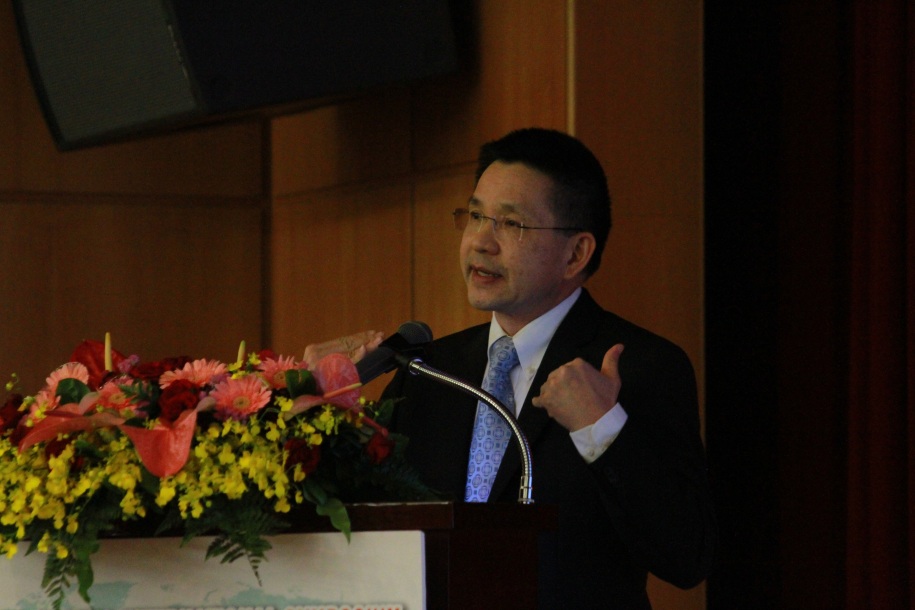
Dr. Wen-Hann Wang is shown presenting his keynote speech titled “Inventing a Smarter Future: Intelligence Everywhere” in APEMC 2015.
In the second keynote speech, Dr. Nicky Lu, Chairman and CEO of Etron Technology, addressed the topic “A perspective on Integrated Circuits in Semiconductors: Technology and Industry,” which is about how IC industries should proceed in the era that Moore’s Law is facing physical limitations. Dr. Lu believed that the miniaturization of ICs will eventually encounter problems that are difficult, or even impossible, to solve. Under the challenging physical limitations, a circuit with a width of only 10 atoms cannot be stably manufactured because such a small photo mask is not yet reliable. In addition, with a circuit of such a small size, the conductor must have a large resistance and the gate in a MOSFET cannot completely turn off, leading to undesirable leaky current. These results will cause high power consumptions and poor signal-to-noise ratios. Furthermore, when circuits become so small, EMC problems will deteriorate, which is one of the problems that this symposium has focused on.
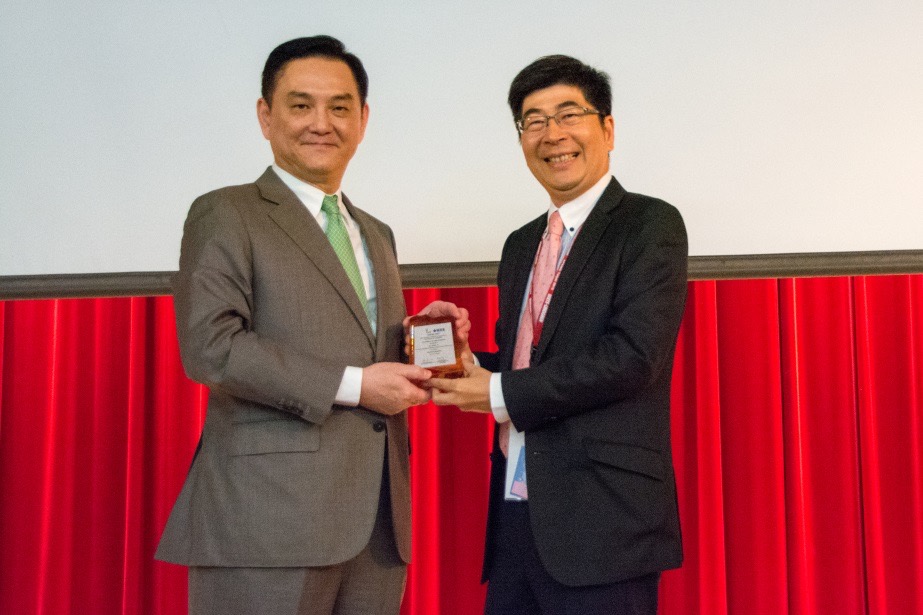
Dr. Nicky Lu of Etron Technology, after addressing on “A perspective on Integrated Circuits in Semiconductors: Technology and Industry,” is shown with Prof. Tzong-Lin Wu .
During the lunch time of May 27, the third keynote speech on “Building Stunning Client Devices” was delivered by Mr. James B. (Jay) Kirkland Jr., Vice President in the Client Computing Group (CCG) and General Manager of reference systems and technology at Intel. He emphasized that, in the next decade of exploding growth in high-speed signal transmission, both industry and academia will face the bottleneck predicted by Moore’s Law. If no breakthrough manufacturing technology appears in the near future, how to promote available products on the basis of the close connection between brand-new concepts and the client’s need will become a key factor in dominating high-tech markets. Although the internet of things (IoT) is no longer a new idea nowadays, thus far no any single company can act as a leader in the IoT market yet. Using Intel as an example, Jay pointed out that pursuing the hardware breakthrough will end up with the challenge of how to dramatically renew manufacturing technology. Hence, as a proof of his viewpoint, he further brought up ASUS’s Transformer Books, a product that does not rely on hardware breakthrough but simply combines two functionally different mobile devices. Regarded as a successful originality, this simple combination not only fulfills the customer’s need but also creates a large market for ASUS itself.

Best Paper Award (BPA) and Best Student Paper Award (BSPA)
Encouraging outstanding young scientists and promising students has been a tradition of APEMC; no exception this year. This symposium offers two academic achievement awards: best paper award (BPA) and best student paper award (BSPA). For each award, 10 finalists were first selected from almost one hundred participants and then reviewed by judges in an interactive poster session. The five BPA winners are Masahiro Yamaguchi (Japan), Flavia Grassi (Italy), Niels Kuster (Switzerland), Jianqing Wang (Japan), and Shih-Hsien Wu (Taiwan); the three BSPA winners include Heegon Kim (Korea), Chi-Kai Shen (Taiwan), and Chin-Yi Lin (Taiwan). The research works of these awards covered quite a broad range of areas, including high-frequency EMC, filter design, wearable devices, and noise protection for space shuttles. In order to thank the winners’ academic contributions, both BPA and BSPA prizes were granted during the conference banquet on May 28.
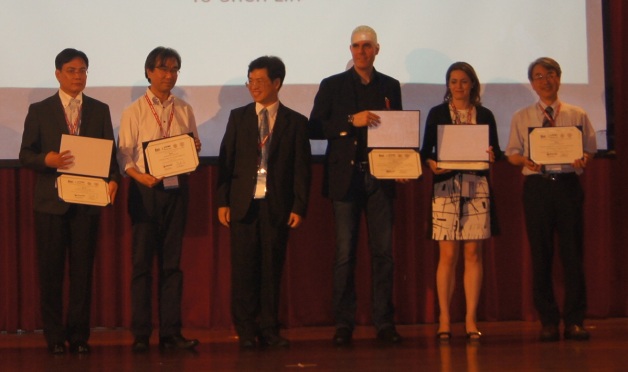
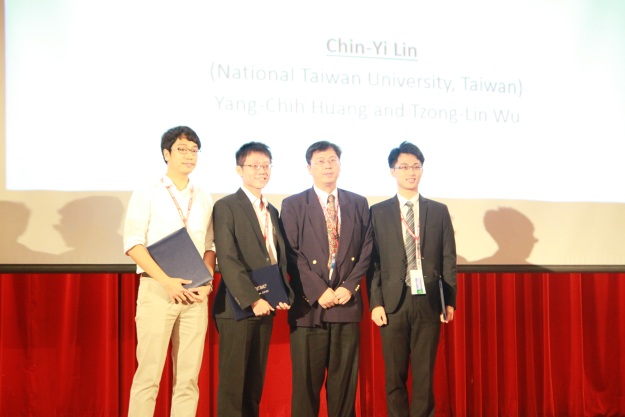
BPA winners (left) and BSPA winners (right) are shown with the award presentation.
Paper Presentations on Versatile Research Areas
In the four-day technical program, scholars and students from all over the world shared their research outcomes and achievements in many rapidly growing EMC-related areas; experts and specialists from industry presented many new technologies that are different from academic viewpoints. Relevant topics include EMC measurement standards, EMC environment, transient EMC, system-level EMC, IC-level EMC, automotive EMC, antennas and EM waves, packaging EMC, signal integrity, power integrity, wireless-communication EMC, computational EMC, biomedical electromagnetics, wireless charging, space EMC, etc.

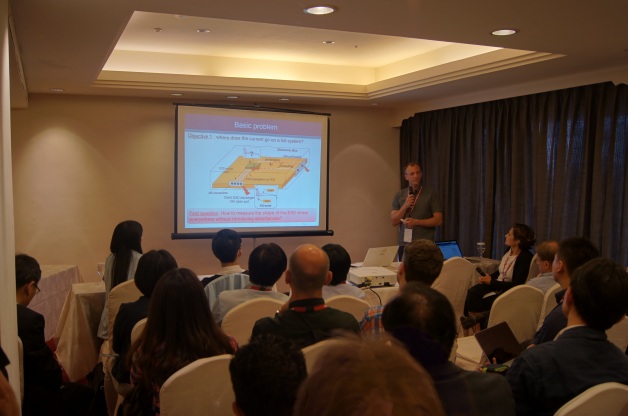
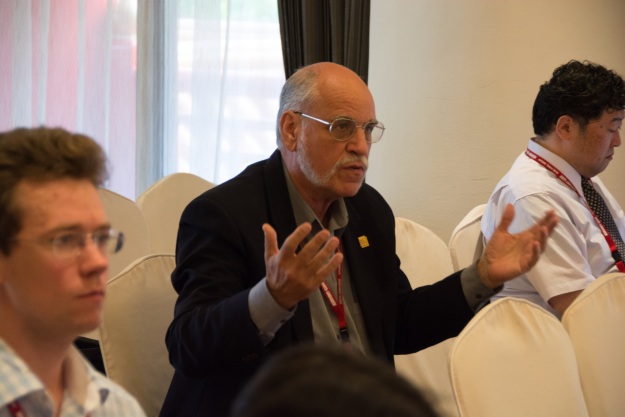
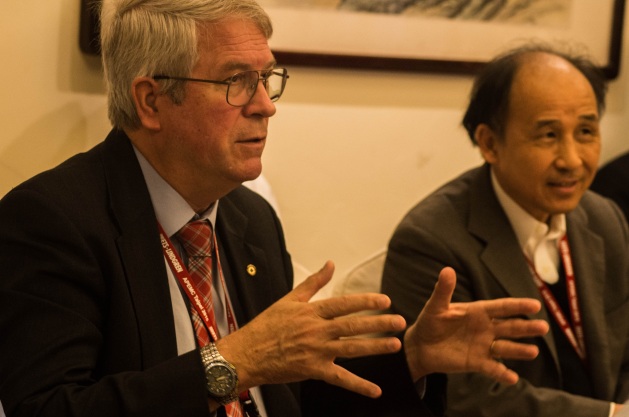


Scenarios
relevant to oral sessions (top four pictures) and poster sessions
(lower two pictures) in APEMC 2015.
Impressive Local Arrangements
Except for activities pertaining to academic discussions, tours and networking sessions were also arranged before and in the conference, respectively. In particular, two technical tours were scheduled. In the first technical tour, more than 18 people visited Taiwan Semiconductor Manufacturing Company (TSMC) located in Hsing-Chu City. People can clearly see how integrated circuits are fabricated step-by-step through a glass curtain. In the second technical tour, more than 15 people visited Automobile Research and Test Center (ARTC) at Changhua. Except for automobile collision labs, EMC test platforms, and the R&D outcomes of ARTC, participants were also taken to the famous old-culture-enriched Lukang town.

Group
pictures taken in TSMC for the TSMC-visiting tour on May 25, 2015.
A welcome reception was held in the night of May 26. A Chinese music band from National Taiwan University of Arts and a Saxophone band from both Chien-Kuo High School and Taipei First Girls High School were invited to perform in the reception. In the same time period, traditional fine-art groups specializing in paper-cut, flour miniature, Chinese digger, and silhouette were also invited to demonstrate their special techniques on site. People attending the reception can experience the Chinese and Taiwanese culture.
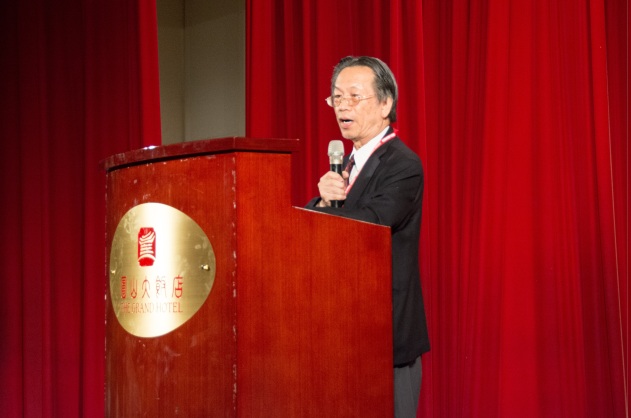

Speeches
delivered by the IAC Chair, Prof. Jin-Fu
Chang
(left) and the IAC Vice Chair, Prof. Ruey-Beei Wu (right), in the
conference banquet.
On
May 28, the conference banquet held in Chinese-culture-enriched Grand
Ball Room was opened by Chinese style dances performed by
dancing-majored students from National
Taiwan University of Arts. After the dance performance, Prof. Jin-Fu
Chang
(Chair of the International advisory committee (IAC) of the this
symposium and President of Yuan Ze University) and Prof. Ruey-Beei Wu
(Vice Chair of IAC and Chief Executive Officer of Institute for
Information Industry)
represented the Taiwan academia and industry, respectively, to thank
attendees from abroad.
Besides the best paper and best student paper awarding ceremony, and besides the report delivered by Prof. Ding-Bing Lin, the symposium also presented a Lifetime Achievement Award to Prof. Song-Tsuen Peng, who initiated the APEMC in Taiwan in 2005. Since 2008, APEMC has been held in many countries other than Taiwan, including Singapore, Japan, China, Korea, and Austrailia. This conference has become a very important international gathering supported by both academia and industry. Without Prof. Peng’s great effeort 10 years ago, we would not see the current blooming status.
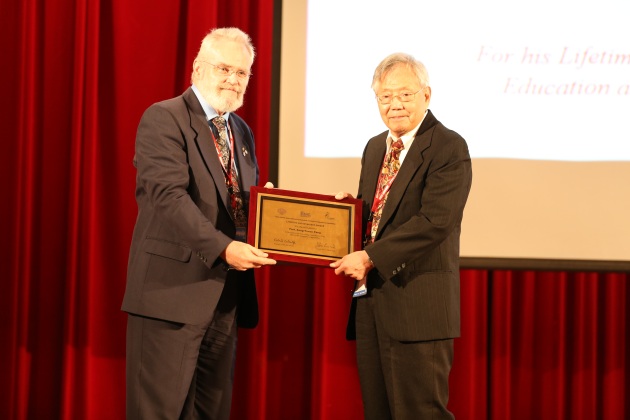
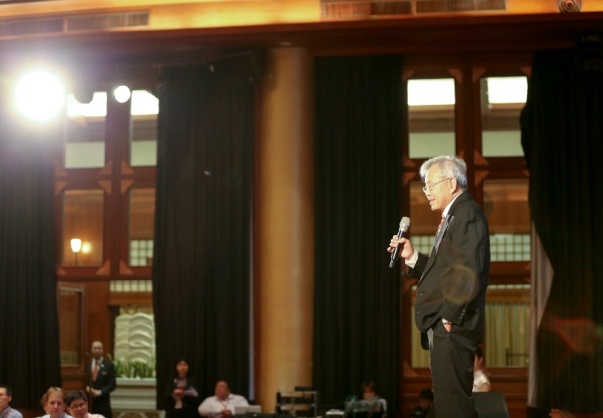
Left
picture: Dr. Robert Scully, President of IEEE EMC Society, presented
Lifetime Achievement Award to Prof. Song-Tsuen Peng. Right picture:
Prof. Peng presented in the conference banquet.
In the May 29 luncheon, people were all looking forward to the lucky draw activity. ASUS donated four recently announced ASUS Zenfones and six ZenPowers. Before the end of the luncheon, Ansys unexpectively added an Apple iPad Air as an additional prize, making the ambience high.
However attractive, APEMC 2015 finally came to an end two hours after the luncheon. The APEMC 2016 will be held from 18-21 May 2016 in Shenzhen, China!